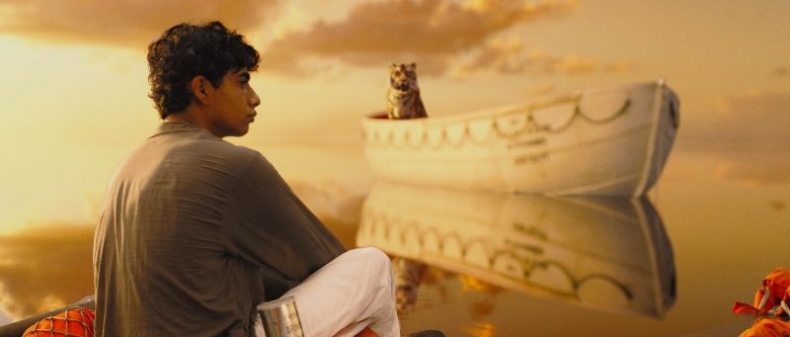
“Life of Pi”
Like the novel it’s based on, Ang Lee’s Life of Pi is a fairly engaging survival yarn bookended by a lot of middlebrow spiritual yammering. Instead of just jumping into the story of an Indian boy adrift in a lifeboat with a ferocious Bengal Tiger, we have to spend a good 45 minutes being briefed on the boy’s unorthodox religious background.
Raised on the grounds of a lush, edenic zoo owned by his parents, young Piscine Molitor Patel — or Pi, for short — is a self-possessed kid with an unusual interest in the divine. Instead of reading superhero comics like other boys his age, he reads biblical comics about Krishna and Vishnu. Though happy with Hinduism, Pi wants more, so he knocks on the door of a Catholic church and learns about Christianity. After that, he heads to a mosque and learns about Islam. As it turns out, Pi loves all three religions, so he combines them and obeys all of their tenets.
I assumed Pi’s burgeoning pantheism would relate in some way to his subsequent godforsaken ordeal, but it never does. It’s barely even invoked again. As far as I could tell, the sole point is to set up a conveniently wishy-washy devotional context, one that embraces all faiths and won’t alienate any potential ticket buyers. You could maybe call the film’s approach “inclusive” rather than pandering, but do we really need to go to such lengths to be inclusive? It’s as if the filmmakers think we couldn’t possibly identify with a protagonist who prays to a god other than our own.
At any rate, by the time Pi reaches the age of 16 his family has decided to leave India due to political unrest (it’s the late 1970s), and they pack up their zoo animals and board a freighter to Canada. Then, somewhere in the middle of the Pacific, the freighter sinks, spilling its human and animal cargo. While his parents and brother go down with the ship, Pi ends up alone in a lifeboat with a wounded zebra, an orang-utan, a nasty little hyena, and a tiger named Richard Parker, all of whom are largely digital creations. Before reading Yann Martel’s book, I assumed the animals would be anthropomorphized, but it’s just the opposite. To Martel’s credit, the animals behave exactly like animals, and the drama is in how Pi uses his knowledge of Richard Parker’s behaviours to keep from being devoured. The story shifts from the philosophical to the logistical, and improves immensely because of it.
The film follows the book’s lead, but it’s only about half as successful. Though the animals remain strictly animal-like, we don’t get all the fascinating descriptions of why they act the way they do and how they can be trained to act differently, nor do we get the convincingly thought-out details of how to survive at sea. We get a bit of both — probably as much as can be expected in a movie — but the emphasis is more on CGI sensation: not just the animals themselves, but the sinking ship, schools of flying fish, terrifying lightning storms, dramatic sunsets, phosphorescent krill, an island covered in meerkats, etc. It’s all impeccably rendered and immersive — Richard Parker in particular is an astoundingly realistic creation — but it’s more virtual-reality simulation than art. The movie is engaging, exciting, and even quite pretty in a candy-coloured way, but never expressive, never truly beautiful.
Everyone keeps saying how Life of Pi would’ve been impossible to make without the technological innovations of the past few years, which is both silly and amnesiac. Way back in the analog 1970s, director Carroll Ballard made practically the same story: The Black Stallion, about a boy and an aggressive, untameable horse who survive a nightmarish shipwreck then get stranded together on a deserted island. (Sure, a live jungle cat would be harder to wrangle than a live horse, but Ballard did just that in a subsequent picture, Duma.) What’s more, The Black Stallion contains all the beauty and wonder Life of Pi so blandly (and expensively) simulates. Without the wonders of CGI, Ballard used his imagination and came up with ingenious, almost abstract compositions that made the world feel new and strange: the horse’s steaming nostrils jutting from a porthole; the horse jumping overboard looking like a Balinese shadow puppet; the boy bobbing in the ocean, menaced by the ship’s exposed propellor blades; etc.
I don’t mean to use The Black Stallion to bludgeon Life of Pi, and I don’t mean to dismiss all CGI as anathema to art. But I do think Life of Pi‘s extensive use of CGI runs counter to its spiritual pretensions. Throughout the book and the movie, we’re encouraged to ponder how god is everywhere and in all things (we’re even told the story will make us believe in God), but surely the best way to illustrate that — maybe the only way to illustrate that — is by showing us the natural world, no? By replacing the real with pixels, the filmmakers remove god from the equation entirely.
____
Scott MacDonald writes about cinema for Toronto Standard. You can follow him on Twitter at @scottpmac. He just started tweeting, so be gentle with him.
For more, follow us on Twitter @TorontoStandard and subscribe to our newsletter.














